When market information floods in at an explosive speed, and project parties continuously release news to encourage output and expand influence, it is often difficult for us to distinguish the truth from the false, and even harder to resist the invasion of FOMO (Fear of Missing Out). The media's hype, whether it is the embellishment of the "get rich overnight" myth or the magnification of market panic, invisibly stimulates our nerves, causing us to jump back and forth on the edge of trading. And those KOLs shrouded in a halo, every time they promote or advertise, may become the last straw that crushes our rational defenses, pushing us into the abyss of emotional trading. These emotional trading behaviors ultimately lead to phenomena such as "chasing highs and killing lows", "frequent trading", and "excessive speculation".
This manual is based on common trading psychology and combines empirical data from traditional finance with data from the cryptocurrency industry to help everyone avoid irrational decisions and use strategies to restrain human weaknesses.
Please feel free to identify yourself!
1. "I sold too early again; should I buy back?"
"I sold too early again!" This may be a sigh of regret that every trader has uttered. When Bitcoin surged from $70,000 to $100,000 historic highs, and when Ethereum soared from $3,000 to $4,500, how many traders sold early as the market started? Often, what follows is an even more dangerous thought: "Should I buy back immediately?" This unbearable FOMO (Fear of Missing Out) emotion is the main culprit behind ineffective trading and profit erosion.
Data Insight: This data is based on research on the trading frequency of individual investors in traditional finance, analyzing the yield performance and trading cost differences of users in different trading frequency intervals. The 20% user group with the lowest trading frequency had an annualized return of up to 18.5%, outperforming all other groups and even exceeding the market benchmark of 16.9%. In contrast, the highest frequency trading group, after incurring trading costs of up to 3.8%, ended with a return rate of only 11.4%, far behind the market.
Comparison of yield and cost share under different trading frequencies
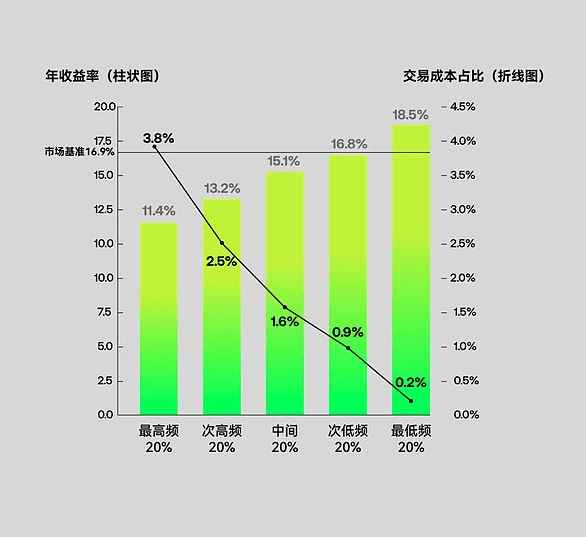
In-depth analysis: Trading too frequently significantly reduces overall yield, which is caused by missing a few key up days. In the long term, holding mainstream assets like Bitcoin for years often yields substantial returns, while frequent trading may weaken profitability. This indicates that "selling too early" is more a strategy error caused by psychological factors.
In this long-distance trading race, less action often beats more action. The frequent operations we attempt to capture every tiny "wave" ultimately cause us to miss out on the grand "tide" of asset value growth, and the profits that should belong to us are ruthlessly "donated" to the market's friction costs.
Solution: Use discipline to overcome impulses. If worried about missing out on a peak but afraid of a rollercoaster ride, tools like grid trading can be used to set staggered profit-taking points.
Strategic Recommendations:
When predicting that assets are in a consolidating upward range, automatically execute low buys and high sells through a spot grid strategy within preset "grid lines", using disciplined automated trading to gradually realize profits during the rise, continuously lowering the holding cost. More importantly, it ensures that the core position is always retained, preventing missing out on subsequent potential surges, fundamentally eliminating the regret of "selling too early" due to hesitation or mistakes in manual operations. The grid makes "passively harvesting segment gains" a reality.
Set position plans in advance. For example, stipulate response strategies for major negative news or only reduce positions when reaching expected target prices. Use data-driven strategies to overcome emotional impulses.
2. "Should I really go all in?"
"This opportunity is rare; while others fear, I am greedy. It's time to go all in!" "Small bets can lead to great victories" "Heavy positions can turn things around". This excessive confidence that amplifies a single opportunity infinitely is the biggest risk source that leads to account wipeout. The most important aspect of investment psychology is the respect for risk.
Data Insight: This data is based on the comprehensive simulation results of institutions regarding long-term U.S. stock data, analyzing the drawdown performance and trading win rates of different position building strategies under extreme market conditions. The "all in" strategy may record the highest returns in certain extreme situations, but its corresponding "maximum drawdown" histogram is also the highest, reaching -54%, with the historical win rate graph located at the bottom. In combination with regular investment and DCA strategies, its maximum drawdown is controlled within a more acceptable range, and the win rate is also more stable.
Comparison chart of position building strategy performance: maximum drawdown and win rate
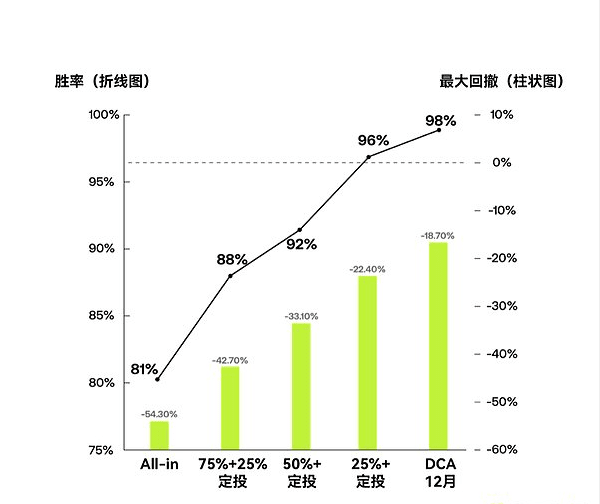
In-depth analysis: The essence of going all in is to use an extremely low win rate to gamble for a theoretically high return, but behind this is the enormous risk that traders cannot bear. As Warren Buffett said, the first principle of investing is "never lose money." Any strategy that could lead to permanent significant losses of principal should not appear in a rational toolbox.
Solution: Use the art of "position management" to hedge against the risks of a "gambler's mentality".
Strategic Recommendations:
Regular investment tools forcibly break down trading plans. Invest a fixed amount at fixed times, and the OKX regular investment function allows users to set price ranges for each investment coin pair, executing regular investment operations only within these price ranges, continuously lowering average costs during the long fluctuations of the market. It forcibly extends your trading behavior across the entire time dimension, using the compounding of time to smooth out price fluctuations, making it the most stable way to build a "core position" and hedge against the risks of going all in.
Flexibly use mixed strategies: Strategies are not either-or; you can split planned trading funds into two parts, for example, one part can be invested all at once in currently reasonably priced assets, while the remainder can be invested periodically weekly or monthly. In a bullish market, the existing position enjoys the rise; if a short-term drop occurs, there is still follow-up capital to buy on dips and lower the average cost.
Regardless of the approach taken, one should set the maximum drawdown percentage they can tolerate. For example, do not invest all tradable assets at once; reserve part of the funds as backup. If a significant loss occurs after a full investment, one can stop and switch to a periodic investment method to average down costs, avoiding emotional increases in positions or stops.
3. "I really can't help it, can I enter?"
When a token goes from professional communities to your casual chat groups, when three months of silence in the group chat becomes wildly active again, when the Google search index skyrockets, the strong FOMO emotion can devour all reason. "Should I buy or not?" Such thoughts repeatedly appear in our minds. However, historical data repeatedly proves that the peak of frenzy often marks the start of a crash.
Data Insight: This data analysis studied the Google search popularity of cryptocurrencies (using DOGE and TRUMP tokens as examples) and the performance of investors' returns 7 days/30 days after entering the market. Reviewing past data of DOGE and TRUMP tokens, when their Google Trends popularity peaked at 100, the subsequent 7-day and 30-day forward return rates were invariably significantly negative. Public sentiment fuels asset prices, but when the fuel burns at its most vigorous moment, it also means it is about to run out. When all potential buyers have entered the market, the momentum for further price increases is lost, leaving only profit-taking and panic selling.
$DOGE Google Trends Index and 7-day/30-day Yield Analysis
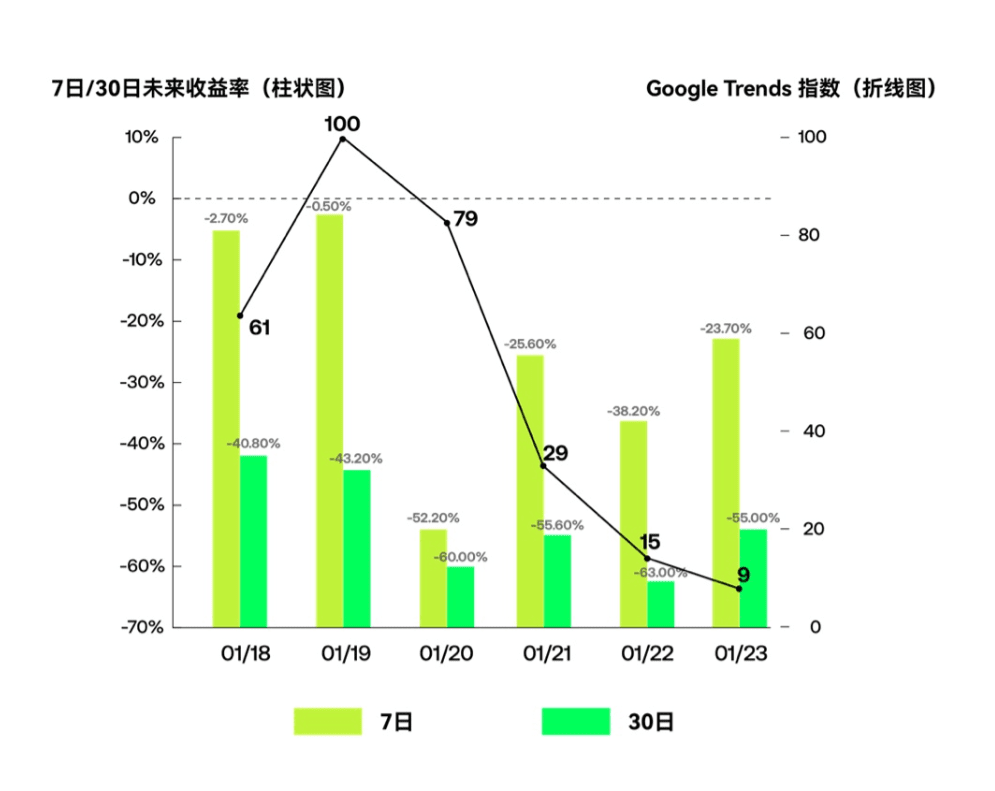
$TRUMP Google Trends Index and 7-day/30-day Yield Analysis
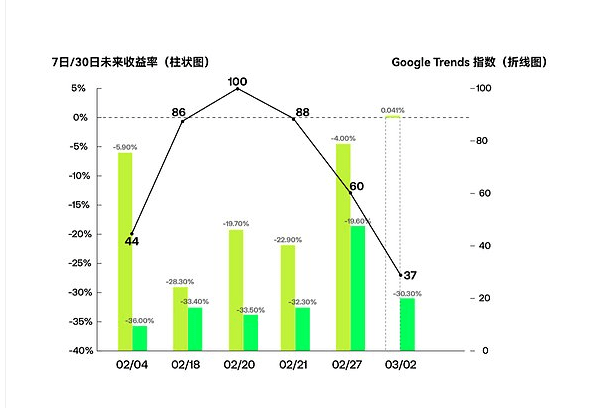
Solution: Use strategies to buffer the risks of chasing highs
When judging that the market trend is not over, how to enter the market becomes the key issue, and it is necessary to prepare a set of scientific, controllable risk follow-up operational plans.
Strategic Recommendations:
Set objective warning lines for heat indicators: Traders can pay attention to data such as Google Trends index, Twitter discussion volume, etc. When the search index of a coin approaches historical peaks or the social media sentiment index is extremely optimistic, be cautious about chasing high.
Utilize staggered entry and stop-profit/loss strategies: If you judge that popularity is surging but the trend may not be over, a spot Martingale strategy can be employed to control risk—the Martingale strategy offers more flexibility in cost control. Split the planned high-buy funds into several portions, buying after the price drops by a fixed percentage. The core goal is to lower the holding cost. At the same time, set tight stop-loss or profit-taking levels for the acquired positions, executing automated selling once reaching suitable selling points or expected profit ratios.
If what you care about is not the price itself, but the market opportunities brought by the heat, then a more stable "risk-neutral" strategy can be adopted. When a coin has extremely high popularity, it usually means that bullish sentiment is strong, and the funding rate in the futures market will be quite considerable. We can use OKX's smart arbitrage to strip away the risk of price fluctuations and specifically earn the "rent" paid by market sentiment.
4. "Could this be another peak?"
The entanglement after profit is no less painful than the suffering during loss. There is both the fear of "locking in profits" and the greed of "missing out on a billion". This human nature game often causes us to miss the best selling point in hesitation. In fact, human nature often finds it difficult to overcome the weakness of greed; manually clearing positions at the market peak in one go is nearly an impossible task.
Data Insight: This data is based on behavioral finance papers, analyzing and comparing the relationship between the average drawdown and the probability of profit retracement (over 15%) in different floating profit intervals over the next 30 days. When the floating profit of a portfolio exceeds +50%, the average maximum drawdown over the next 30 days reaches 25%, while the probability of a significant profit retracement (over 15%) sharply rises to 54%. Classic papers in behavioral finance also point out that individual traders often sell too late due to "greed", leading to significant profit shrinkage.
Future returns and retracement risks in different floating profit intervals
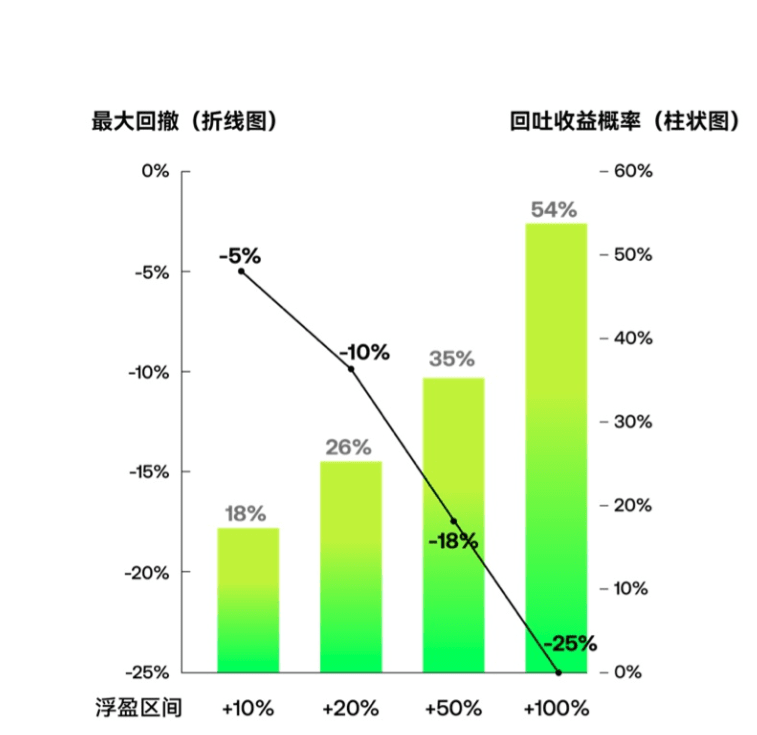
In-depth analysis: When the risk-reward ratio begins to turn unfavorable, disciplined staggered profit-taking is the only way to convert "paper wealth" into real wealth.
Solution: Let robots help you "secure profits." Manual profit-taking is the ultimate test of human nature. Strategy tools can perfectly execute this discipline.
Strategic Recommendations:
For ordinary traders, a more realistic and wiser choice is to abandon the obsession with "selling at the highest point" and instead pursue "selling at a relatively high price range", using automated strategy tools to gradually realize profits. In contrast to position building, when the price enters the "bubble zone" or reaches profit targets, a "reverse pyramid" selling strategy can be adopted. As the price continues to rise, the portion sold each time increases. For example, sell 10% at $100,000, 20% at $110,000, and 30% at $120,000. This method ensures that the most positions are sold at the peak.
5. "Wait for recovery to sell? Should I cut losses?"
"Loss aversion" is a psychological bias etched in human genes. We would rather endure the long-term pain of being trapped than accept the short-term pain of "cutting losses", which signifies admitting failure. However, data tells us that for deeply trapped assets, time is often poison, not a cure. Traders tend to remain inactive or increase positions to lower costs during losses, unwilling to decisively cut losses, leading to a very common phenomenon of continuously holding onto losing assets. This behavior is known as the disposition effect: traders often sell winning positions too early while holding onto losing positions for a long time in hopes of breaking even someday.
Data Insight: This data is based on a comparative study of the correlation between trading behavior in different loss states and recovery days using data from the U.S. stock and cryptocurrency markets. The deeper the floating loss of an asset, the lower the historical probability of successful recovery, while the time required for recovery grows exponentially. When losses reach -50%, to recover, the asset price needs to rise by 100%, often taking more than 120 days. In the cryptocurrency market, this means waiting for the next bull market cycle, with significant time and opportunity costs. Moreover, during a loss state, trading frequency significantly increases, and emotional trading can exacerbate losses.
Correlation between trading behavior in loss state and recovery days
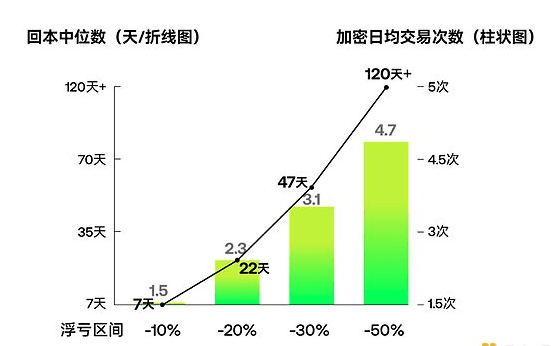
In-depth analysis: Passive "holding on" is essentially a paralysis of decision-making. It locks valuable funds into inefficient or even "zero" assets, causing us to miss other potential opportunities in the market. Active risk management and proactive position optimization are far more valuable than hopeless waiting.
Some traders become passive and nearly stop any operations after incurring losses, hoping for miraculous rebounds; another group, however, shows heightened trading impulses, frequently engaging in short-term trades to "average down" or quickly compensate for losses. Both behaviors can be irrational. The former misses the opportunity cost of stopping losses or dynamically adjusting, while the latter easily exacerbates losses due to emotional trading.
Solution: Scientifically "self-rescue" rather than passively "holding on"
Strategic Recommendations:
Set clear stop-loss and dynamic adjustment principles: Plan for the worst-case scenario when buying: if the drop exceeds a certain percentage or if certain negative changes in fundamentals occur, stop-loss unconditionally. A staggered stop-loss strategy can also be adopted: for example, sell part of the position at a certain resistance level after each rebound, or reduce a portion each time a new support level is broken, spreading the risk. Quantifying discipline can avoid the procrastination of subjectively waiting for recovery. After stopping losses, maintain a period of calm to prevent immediately making emotional purchases of other coins, leading to repeating mistakes.
Minimize losses rather than cling to recovery: Shift attention from "recovering losses" to "how to minimize losses and regain profit". Sometimes, admitting losses and reallocating remaining funds into more promising assets is more likely to recover losses. For example, rather than being stuck in a long-term losing position in a certain altcoin, it may be better to cut losses and buy into more promising coins on dips in the next round of market fluctuations.
BTC ETH PEPE


